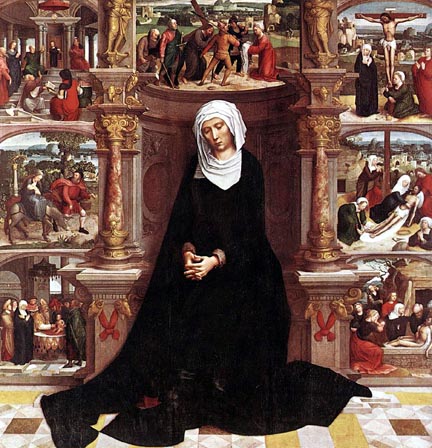It is a music, no it’s not a music, but I feel it is a story about one women who tries to tell us about her sad stories. Depression, sorrow, and her excitement simultaneously push my heart. She is whispering me softly….. When I open my eye, I find myself in an orchestra hall.
(In fact, we are not allowed to take photo in the hall)…
Our lady is Virgin Mary.
 Our Lady of the Seven Sorrows
Our Lady of the Seven Sorrows
Adriaen Isenbrant
1518-35
Panel
O.L. Vrouwekerk, Bruges
The Virgin Mary, who believed in the word of the Lord, did not lose her
faith in God when she saw her Son rejected, abused and crucified. Rather she
remained beside Jesus, suffering and praying, until the end. And she saw the
radiant dawn of His Resurrection. Let us learn from her to witness to our
faith with a life of humble service, ready to personally pay the price of
staying faithful to the Gospel of love and truth, certain that nothing that
we do will be lost.
— Pope Benedict XVI, Angelus – September 13, 2009♥ Stabat Mater (Poulenc)
- Stabat mater dolorosa (Très calme)悲しみに沈める聖母は涙にくれて
- Cujus animam gementem (Allegro molto–Très violent) 嘆き悲しみ、苦しめる御子の魂を
- O quam tristis (Très lent) おお、神のひとり子の
- Quae moerebat (Andantino) 尊き御子の苦しみを
- Quis est homo (Allegro molto—Prestissimo) これほどまでに嘆きたまえる
- Vidit suum (Andante) また瀕死のうちに見捨てられ
- Eja mater (Allegro) 愛の泉なる御母よ
- Fac ut ardeat (Maestoso) わが心がその御心にかなうべく
- Sancta mater (Moderato–Allegretto) 聖なる母よ
- Fac ut portem (To. de Sarabande) われにキリストの死を負わしめ
- Inflammatus et accensus (Animé et très rythmé) おお乙女よ、審判の日に
- Quando corpus (Très calme) 肉体が死するとき


